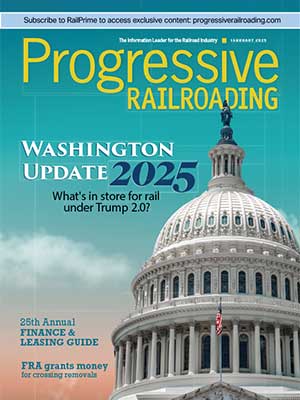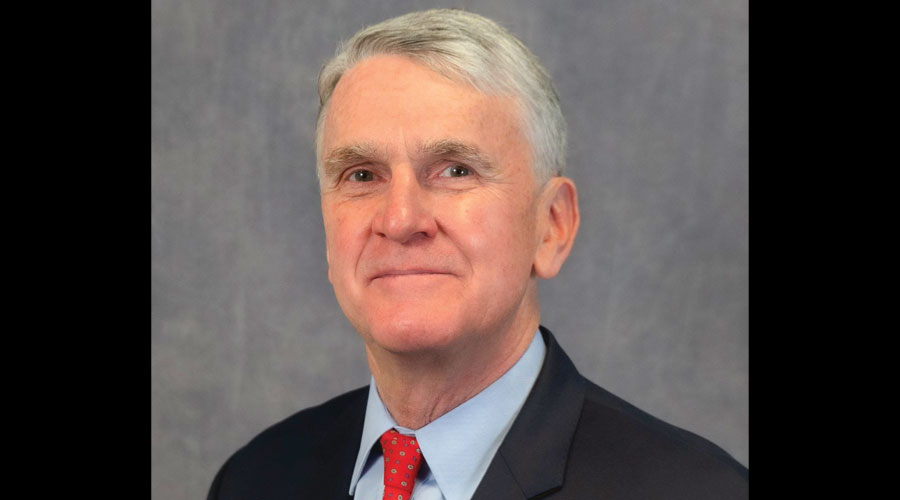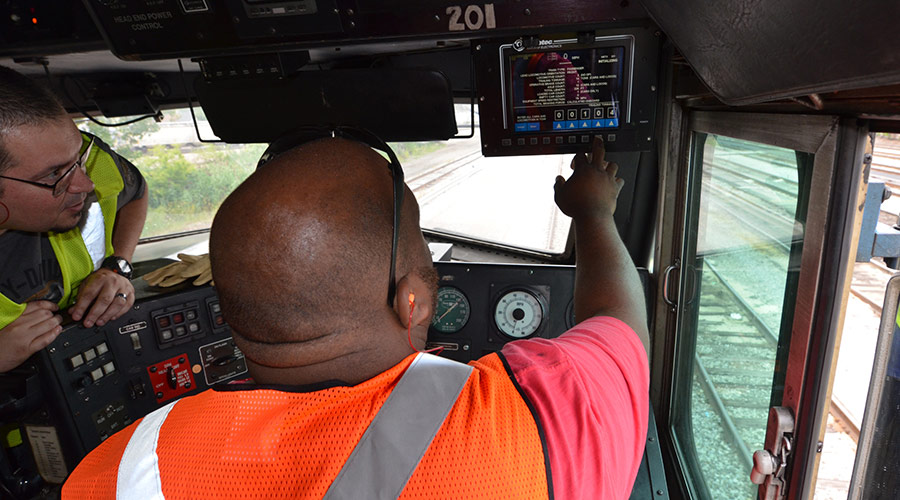Stay updated on news, articles and information for the rail industry
April 2011
Rail News: PTC
Positive train control: Onboard PTC technology
by Robert J. Derocher
Positive train control. Marshall Beck has been hearing those three words or equivalent phrases for years. And the senior vice president of New York Air Brake continues to hear that phrase, and that abbreviation (PTC) that's become a word all its own. What's different these days is the PTC conversation isn't just talk.
"There's a lot of debate right now about how many cab displays there should be and where they should be placed," Beck says. "When you see that [the discussion] has migrated to that, you know things are coming."
Suppliers of PTC-related technology believe they are well-positioned to help the 40-plus U.S. railroads complete the onboard segment of their federally mandated systems by Dec. 31, 2015. Class Is continue to conduct tests and products (new, as well as the tried and true) now are on the market. Meanwhile, railroads and suppliers continue to monitor PTC systems already in place, such as Alstom Transport's Advanced Civil Speed Enforcement System (ACSES II) on Amtrak's Northeast Corridor and Ansaldo STS' VitalNet on the Alaska Railroad Corp.
A Key Piece of the Puzzle
Although concerns about cost, interoperability, final product designs and performance need to be resolved during the next few years, suppliers expect freight and passenger railroads to have a timely rollout of PTC. The selection of onboard technology is a key piece of the PTC implementation puzzle, and railroads are beginning to make a few of their selections public.
Last month, Wabtec Corp. inked a $27 million deal to provide PTC equipment and services to Metrolink in southern California by 2012 — three years ahead of the congressional deadline.
"We're willing to help anyone in the industry that we can [with PTC]," says Jeff Stearns, Wabtec's vice president of train control systems.
Metrolink officials have been aggressive in their pursuit of PTC since a September 2008 fatal collision on the commuter railroad's line led to passage of the Rail Safety Improvement Act of 2008, which mandates that PTC be installed on about 73,000 miles of track used to transport passengers and certain hazardous materials by 2015's end.
(Note: Last month, the Federal Railroad Administration [FRA] and Association of American Railroads [AAR] reached an agreement under which the FRA will issue a new proposed rulemaking to reduce the number of route miles requiring PTC systems by about 10,000 miles.)
In some locations, the technology has been in place for some time. Alstom's ACSES and its successor ACSES II have been in operation for more than a decade on Amtrak's Northeast Corridor.
"It remains our core [PTC] system," says Scott Sherin, Alstom's vice president of business development. "This is not an unproven technology."
Focus on Transits
Alstom's onboard PTC efforts are concentrated in transit, with ACSES II being the only PTC system in revenue service under the Rail Safety Improvement Act and the first such system to receive FRA approval, says Steve Zwart, Alstom's customer director of PTC.
Transit agencies currently looking at implementing ACSES II include the Southeastern Pennsylvania Transportation Authority, New Jersey Transit, Massachusetts Bay Transportation Authority, MTA Long Island Rail Road and MTA Metro-North Railroad, Zwart says.
Additionally, some Maryland Area Regional Commuter (MARC) locomotives in Amtrak's Northeast Corridor are equipped with the system, he says.
To address railroads' concerns about the onboard space required for PTC components, Alstom trimmed the footprint of its Vital OBC (onboard computer) by more than 50 percent, and added more computing power, Zwart says. Alstom also is developing plans for a new centralized customer support and service facility expected to open in Delaware in about two years, Zwart says.
Meanwhile, officials at Invensys Rail North America banked on what they, too, believe is a proven PTC technology when the company acquired Quantum Engineering Inc. in 2008. Quantum's Train Sentinel® PTC system has been in operation on the Panama Canal Railway Co. since 2006 with good results, and now is the core component for Invensys Rail North America's new U.S.-compliant onboard PTC system, company officials said via e-mail.
"The most obvious changes to the existing product were the new requirements for interoperability, which have largely been implemented at this time," they said. "One of the stronger features of the onboard suite was the advanced braking algorithms that are embedded in the system."
What Customers Want
What are customers looking for regarding PTC/onboard technology?
"The recurring theme seems to center on the need for multiple suppliers of onboard equipment, reliable communications and a robust braking algorithm," Invensys Rail North America officials added.
As for any technology the company may have in the planning or testing stage: "While it is premature to comment, we do have several larger rail customers engaged for testing the product, in conjunction with our wayside interface units," company officials said.
Also part of the onboard PTC mix is another established product: New York Air Brake's Locomotive Engineer Assist/Display and Event Recorder (LEADER).
Although LEADER is not "a key player in the core aspect" of onboard PTC, the system can be integrated easily into any PTC system, New York Air Brake's Beck says. As a fuel savings system, LEADER is designed to optimize train handling, which should make it easily fit in with PTC, he says.
As PTC implementation nears, there will be "nuances in giving commands to PTC" that will need to be worked out when LEADER is integrated into the overall system, Beck says. For example, "if a PTC network would like to see a train move a little more quickly, then LEADER will respond," he says. "It's about energy management. LEADER will defer to PTC on safe operations."
The Tweaking and Testing Continues
For Wabtec, the move toward the final PTC implementation phase "is the culmination of a lot of years of hard work," Stearns says. "We've got 30 years of project development and testing behind us."
Wabtec is in various stages of final testing and design implementation of onboard PTC with the "big four" U.S. Class Is — Union Pacific Railroad, BNSF Railway Co., Norfolk Southern Railway and CSX Transportation — with an eye toward helping them meet the federal timetable, Stearns says.
"[The railroads] all have different schedules — they all have different plans," he adds.
In the meantime, the technology tweaks and tests will continue. For Gregory Allen, director of business development for PTC at Ansaldo STS, perhaps the largest issue to resolve is interoperability. The company is working with all of the Class Is and several commuter railroads on PTC implementation, he says.
"The situation related to the Class I railroads due to the PTC mandate is well known, but there are similar interoperability requirements in these other market segments, such as trains operating on Amtrak and the Northeast Corridor commuter lines," Allen says.
Some of the biggest onboard adjustments likely will be related to newly developed protocols for radio communication, as well as new AAR standards that could affect the packaging of onboard electronics, such as the VitalNet Cab, the onboard computer for Ansaldo's PTC system, Allen says.
"We're reviewing these standards to assess the impacts on our product offerings," he adds. "This impacts not only the onboard equipment, but wayside and central office products, as well."
Combining a number of different onboard functions, and making sure they can operate in both freight- and passenger-rail environments and across different sections of track owned by different railroads will be a challenge for the next few years, Alstom's Zwart says.
"There's a lot of education taking place in the industry about PTC," he adds. "Every customer has different interface and a different view of how PTC should work on board."
But unlike the previous decades of discussion, delay and indecision, supply-side veterans like New York Air Brake's Beck know the arrival of PTC is at hand.
"[It's] a matter of time," he says.
Robert J. Derocher is a Loudonville, N.Y.-based free-lance writer.


 What’s In Store For Rail Under Trump 2.0?
What’s In Store For Rail Under Trump 2.0?
 Richard Kloster: Rail Industry On Promising Path
Richard Kloster: Rail Industry On Promising Path
 Much Ado With Latest Monitoring Systems, Equipment
Much Ado With Latest Monitoring Systems, Equipment
 Rail Insider eBook
Rail Insider eBook
 railPrime
railPrime







